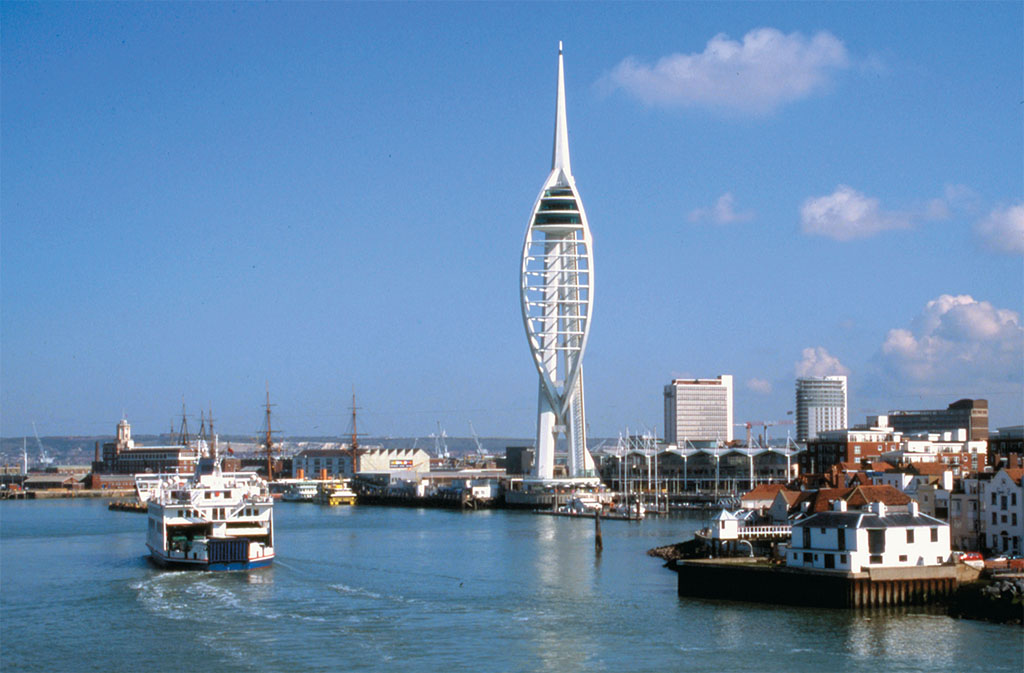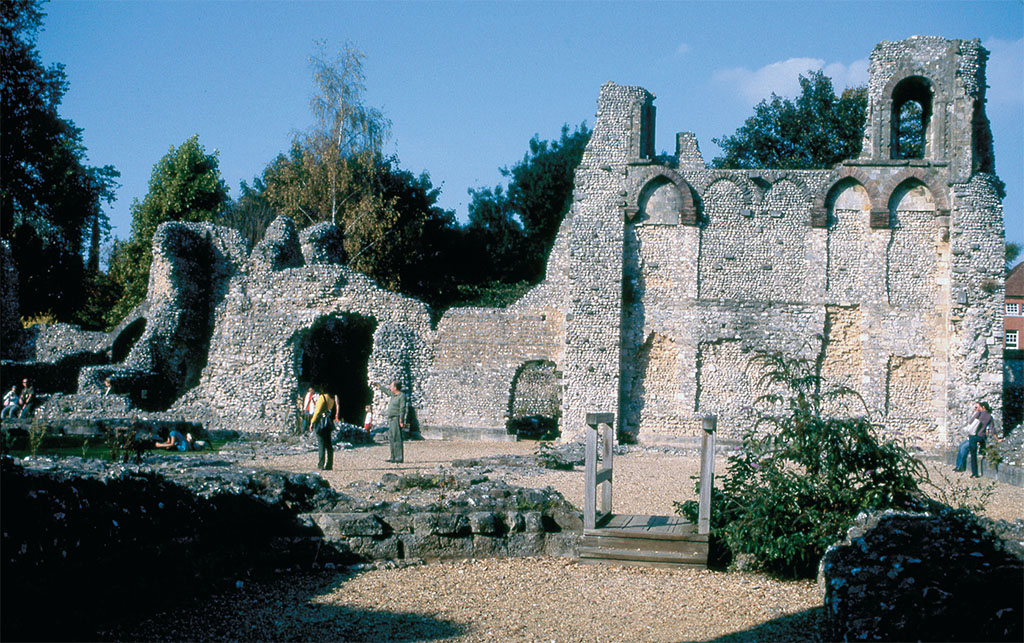
[caption id="HampshireandtheIsleofWight_img1" align="aligncenter" width="1024"]

IT WOULDN’T BE QUITE FAIR to say that Hampshire is overlooked as a destination by American visitors, though for all its diversity, scenic beauty, historic treasures and proximity to London, the county seems to maintain a pretty low profile. That makes it all the more fun to explore. Here is a delightful and colorful introduction to historic Hampshire and the Isle of Wight, with easy driving distances and a balanced mix of town and country.
Day 1 On the Road to Saxon Wessex
There are several routes southwest to the central coastal county of Hampshire. From the airports or central London, though, the most fun jumps off the M25 at Junction 10 for the A3 to Guildford. Our destination is Winchester, capital of Alfred the Great’s kingdom of the West Saxons. Straight through, you could drive it in an hour, but getting there is half the fun. The first turn to the right on the A3 takes you to Wisley, the flagship gardens of the Royal Horticultural Society—magnificent in any season of the year. At Guildford, you might follow the signs for a short visit to England’s first 20th-century cathedral perched on a hilltop campus above the city. From Guildford, take the A31 toward Alton over the “Hog’s Back,” a narrow ridge offering great views over the Downs. At Farnham, do take a short detour to visit 12th-century Waverley Abbey, the first Cistercian monastery in England. Just stroll across the watermeadow and wander in the ruins. At Alton, you can take a ride on the MidHants Railway, enjoying a steam train excursion on the “Watercress Line.” The nearby village of Chawton was home to Jane Austen. Her house is a wonderful introduction to the novelist’s life and works. Jane’s mother and sister are buried in St. Nicholas churchyard. The historic cathedral city of Winchester lies just down the road.
Day 2 On the Razzle in Winchester
A lot of folk breeze in and out of Winchester, but this delightful ancient small city on the River Itchen richly repays a day’s exploration. The Tourist Information Centre in the Guildhall at the base of the High Street is a great place to start. Just in back of the TIC is the close of Winchester Cathedral, with the longest medieval nave in Europe and 900 years of colorful history. Look for the grave of Jane Austen, where throughout 2013 a richly illustrated exhibition unpacks her life and work in Hampshire.
The pedestrianized High Street, lined with great shops, eateries and pubs, leads uphill to the surviving Great Hall of Winchester Castle. No, that’s not really King Arthur’s Round Table hanging on the wall. Perhaps visit in the great military museums next door. Another great visit is the City Mill down on the river. Then, perhaps take a walk through the water meadows. Just follow the path along the River Itchen to St. Cross Hospital, where you can request the Wayfarer’s Dole (see p. 54). You might do afternoon tea and little shopping on the High Street, or finish the afternoon with a return to the cathedral at 5:30 for choral evensong. An unforgettable experience.
[caption id="HampshireandtheIsleofWight_img2" align="aligncenter" width="1024"]

[caption id="HampshireandtheIsleofWight_img3" align="aligncenter" width="662"]

Day 3 To The New Forest
Turning southwest this morning, take the A3090 about 10 miles to Romsey. Do pay a call at Romsey Abbey, its Saxon foundations dating to Alfred’s time. On the edge of town, Broadlands, home of the Mountbatten family, is a great visit in season. When the roses are in bloom, check out the famous collection of old-fashioned varieties at Mottisfont Abbey. Or continue on southwest to the New Forest and its “capital” town, Lyndhurst. The best introduction to this ancient hunting preserve is the New Forest Visitors Centre with a car park just off the main street. The small towns of Lyndhurst or Brockenhurst are the places to stay—with wild, New Forest ponies wandering through the villages at will. If time permits, do take another day to explore the forest. This afternoon, however, you might take one of the beautiful ornamental drives, or pay a visit to Exbury Gardens, the National Motor Museum or the ship-building village of Bucklers Hard.
Day 4 Yonder the Isle of Wight!
It’s only eight miles south to Lymington this morning to catch the ferry across the Solent to the Isle of Wight. You’ll land in Yarmouth. Head first to The Needles and the Old Battery, where Marconi set up his first wireless telegraph station. Then carry on to Freshwater Bay and the A3055 coast road along the south edge of the island. There’s an aquarium along the way, a famed amusement park at Blackgang Chine and lovely botanic gardens at Ventnor. The east coast from Ventnor to Shanklin and Sandown is traditional holiday seaside, with lovely beaches and all the accoutrements—including plenteous accommodation choices for every budget. Shanklin Old Village, which grew up around Shanklin Chine (maybe the closest thing Britain has to a tropical rain forest), is a particularly quaint location. You’ll find other explorations along the way.
Day 5 An Island Panorama
The IOW offers a wonderful day, with a real island feel to it. At roughly 20 miles by 13 miles, it’s not hard to get around. Head inland through the garlic fields to Newport, the island’s county town, for a visit to Carisbrooke Castle where the ill-fated King Charles I was held in captivity. Then, it’s north just a few miles to Cowes, the center of British yachting and scene of famous Cowes week, to wander about the colorful waterfront. The A-list visit in East Cowes is Osborne House, the private retreat of Queen Victoria and her family; it’s the most popular visit on the island and deserves to be. On a sunny day, of course, you might reserve some time for the beach or seaside attractions at Sandown or Shanklin. As always, of course, where there’s holiday resort, there are plenty of nightlife and dining options.
Day 6 Wherever the Road Winds
If you’re heading off island today, take the ferry from Fishbourne to Portsmouth in 45 minutes. That’s the Spinnaker Tower looming over the harbor. As home of the Royal Navy, Portsmouth is awash in maritime history to be explored if time permits: the first iron-hulled warship, HMS Warrior, Nelson’s Victory, the Royal Navy Museum and much more. If you are back to London today, the most direct route is the A3, which leads northeast back to the M25 in an hour or so. If you’ve more time, turn east from Portsmouth and explore the Sussex coast to Chichester, Arundel and Brighton.





Comments